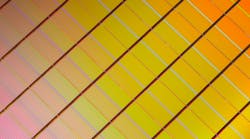Robert Crooke, vice president of Intel’s nonvolatile memory business, and Mark Durcan, Micron’s former chief executive officer, were standing on the stage in Silicon Valley, hands resting on the doors of a white triangular case, grinning out at the darkened seats. They opened the doors together showing a shimmering wafer and giving the room the first glimpse of 3D XPoint, the new memory Intel codeveloped with Micron.
Almost three years have passed since the executives announced XPoint, which had been a closely guarded secret for many years. But the companies have announced plans to stop collaborating on XPoint technology next year. After putting the finishing touches on their second generation memory chips in the first half of 2019, they plan to part ways on future development.
Intel and Micron will continue fabricating the technology at the IM Flash Technologies factory they share. But the companies will independently fund new iterations of the technology, which combines the speediness of DRAM with the longer-term storage of NAND. XPoint can be plugged into servers used by companies ranging from Microsoft to Goldman Sachs, which store and process huge amounts of data.
The chips are manufactured with thin columns of memory cells stacked tightly in a three-dimensional crosshatch pattern that allow the cells to be written and accessed individually, improving on the latency and endurance of NAND. XPoint can also save information after being powered down, unlike DRAM, which is erased without a constant power supply. Despite being more costly, DRAM can be written to faster than 3D XPoint.
Development is winding down as the companies suspend working together on 3D NAND, in which integrated circuits are layered on top of each other to boost capacity. Several months ago, Intel and Micron announced that they would pull the plug on the development deal after the third generation of memory is completed. That is expected by the end of 2018 or early 2019.
These are significant changes to Intel and Micron’s IM Flash venture, which was founded in 2006. The subsidiary, which employs about 1,700 people, manufactures non-volatile memory, including NAND used in smartphones and other sorts of electronic devices. In 2015, the companies began XPoint memory production at the 300-millimeter wafer fab located in Lehi, Utah.
Micron is scarfing down profit as prices soar for long-term storage and short-term memory used in everything from data centers to smartphones. But the Boise, Idaho-based company is walking a financial tightrope with XPoint. Micron only plans to release chips based on XPoint next year, while Intel has been shipping its own product line, called Optane, targeting personal computers and corporate servers since last year.
In exchange for sharing the multibillion-dollar costs of operating the IM Flash factory, Micron and Intel take home roughly an equal share of wafers. But since its products are still chambered, Micron has been unloading its share to another company in recent months to defray operational costs. Micron has been losing money because the company, rumored to be Intel, is unable to use its full share.
The calculus is complicated by its recent investment with Intel into expanding the factory’s production of XPoint wafers. Micron could recover some costs by supplying more wafers to Intel, which is ramping up new products based on XPoint. Intel is currently sampling modules, codenamed Apache Pass, that could challenge DRAM in servers. Intel said that it would generate revenue from Apache Pass before the end of the year.
Today, storing data inside a computer’s main memory means hauling it over to nonvolatile memory connected through the PCIe socket. Intel’s DIMMs use the memory bus to connect to the processor, like DRAM, reducing that time-consuming process. XPoint is not fast enough to replace DRAM, but analysts say it offers costs and performance benefits over solid state drives.
Micron’s hopes are high. The company “will continue driving the next generations of 3D XPoint technology,” said Scott DeBoer, vice president of technology development, in a statement. “By developing 3D XPoint technology independently, Micron can better optimize the technology for our product roadmap while maximizing the benefits for our customers and shareholders.”








